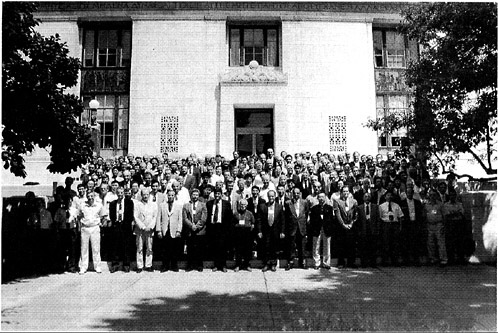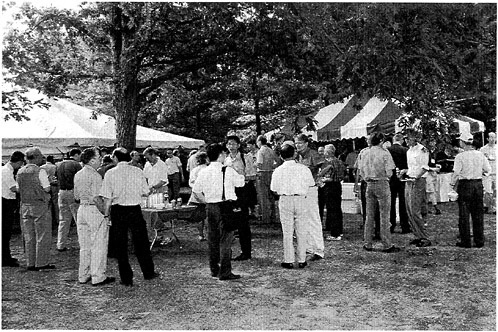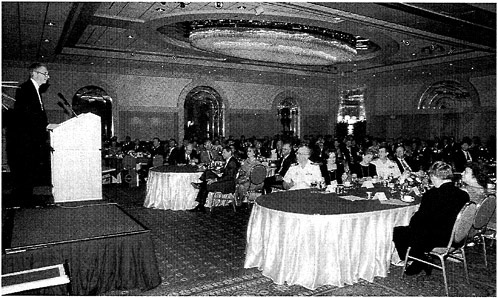Twenty-Second Symposium on
NAVAL HYDRODYNAMICS
Hydrodynamics in Ship Design
Propulsor Hydrodynamics/Hydroacoustics
Cavitation and Bubbly Flows
Frontier Experimental Techniques
Wave-Induced Ship Motions and Loads
Viscous Ship Hydrodynamics
Shallow Water Hydrodynamics
Water Entry and Wake Dynamics
Bluff Body Hydrodynamics
Fluid Dynamics in the Naval Context
Wave Hydrodynamics
CFD Validation
Twenty-Second Symposium on NAVAL HYDRODYNAMICS
Hydrodynamics in Ship Design
Propulsor Hydrodynamics/Hydroacoustics
Cavitation and Bubbly Flows
Frontier Experimental Techniques
Wave-Induced Ship Motions and Loads
Viscous Ship Hydrodynamics
Shallow Water Hydrodynamics
Water Entry and Wake Dynamics
Bluff Body Hydrodynamics
Fluid Dynamics in the Naval Context
Wave Hydrodynamics
CFD Validation
NATIONAL ACADEMY PRESS
Washington, D.C.
1999
The National Research Council serves as an independent advisor to the federal government on scientific and technical questions of national importance. Established in 1916 under the congressional charter of the private, nonprofit National Academy of Sciences, the Research Council brings the resources of the entire scientific and technical community to bear on national problems through its volunteer advisory committees. Today the Research Council stands as the principal operating agency of both the National Academy of Sciences and the National Academy of Engineering and is administered jointly by the two academies and the Institute of Medicine. The National Academy of Engineering and the Institute of Medicine were established in 1964 and 1970, respectively, under the charter of the National Academy of Sciences.
The National Research Council has numerous operating units. One of these is the Naval Studies Board, which is charged with conducting and reporting on surveys and studies in the field of scientific research and development applicable to the operation and function of the Navy.
A portion of the work done to prepare this document was performed under Department of Navy Contract N00014–98-I-0526 issued by the Office of Naval Research under contract authority NR 201–124. However, the content does not necessarily reflect the position or the policy of the Department of the Navy or the government, and no official endorsement should be inferred.
The United States Government has at least a royalty-free, nonexclusive, and irrevocable license throughout the world for government purposes to publish, translate, reproduce, deliver, perform, and dispose of all or any of this work, and to authorize others so to do.
International Standard Book Number 0-309-06537-2
Copyright 1999 by the National Academy of Sciences. All rights reserved.
Printed in the United States of America
NAVAL STUDIES BOARD
Vincent Vitto,
Charles Stark Draper Laboratory, Inc.,
Chair
Joseph B.Reagan,
Lockheed Martin (retired),
Vice Chair
David R.Heebner,
Science Applications International Corporation (retired),
Past Chair
Albert J.Baciocco, Jr.,
The Baciocco Group, Inc.
Alan Berman,
Applied Research Laboratory, Pennsylvania State University
Norman E.Betaque,
Logistics Management Institute
James P.Brooks,
Litton/Ingalls Shipbuilding, Inc.
Norval L.Broome,
Mitre Corporation
Gerald A.Cann,
Rockville, Maryland
Ruth A.David,
Analytic Services, Inc.
Paul K.Davis,
RAND
Seymour J.Deitchman,
Institute for Defense Analyses (retired),
Special Advisor
Anthony J.DeMaria,
DeMaria ElectroOptics Systems, Inc.
Frank A.Horrigan,
Raytheon Systems Company
Richard J.Ivanetich,
Institute for Defense Analyses
Miriam E.John,
Sandia National Laboratories
David W.McCall,
AT&T Bell Laboratories (retired)
Robert B.Oakley,
National Defense University
Harrison Shull,
Naval Postgraduate School (retired)
James M.Sinnett,
Boeing Company
Keith A.Smith,
USMC (retired), Vienna, Virginia
Robert C.Spindel,
Applied Physics Laboratory, University of Washington
David L.Stanford,
Science Applications International Corporation
Paul K.Van Riper,
USMC (retired), Williamsburg, Virginia
Verena S.Vomastic,
Institute for Defense Analyses
Bruce Wald,
Center for Naval Analyses
Mitzi M.Wertheim,
Center for Naval Analyses
Navy and Marine Corps Liaison Representatives
RADM Raymond C.Smith,
USN, Office of the Chief of Naval Operation (N91)
RADM Paul G.Gaffney II,
USN, Office of the Chief of Naval Operations (N81)
LtGen John E.Rhodes,
USMC, Commanding General, Marine Corps Combat Development Command
Ronald D.Taylor, Director
COMMISSION ON PHYSICAL SCIENCES, MATHEMATICS, AND APPLICATIONS
Peter M.Banks,
ERIM International,
Co-Chair
W.Carl Lineberger,
University of Colorado,
Co-Chair
William Browder,
Princeton University
Lawrence D.Brown,
University of Pennsylvania
Marshall H.Cohen,
California Institute of Technology
Ronald G.Douglas,
Texas A&M University
John E.Estes,
University of California at Santa Barbara
Jerry P.Gollub,
Haverford College
Martha P.Haynes,
Cornell University
John L.Hennessy,
Stanford University
Carol M.Jantzen,
Westinghouse Savannah River Company
Paul G.Kaminski,
Technovation, Inc.
Kenneth H.Keller,
University of Minnesota
Margaret G.Kivelson,
University of California at Los Angeles
Daniel Kleppner,
Massachusetts Institute of Technology
John Kreick,
Sanders, a Lockheed Martin Company (retired)
Marsha I.Lester,
University of Pennsylvania
M.Elisabeth Paté-Cornell,
Stanford University
Nicholas P.Samios,
Brookhaven National Laboratory
Chang-Lin Tien,
University of California at Berkeley
Norman Metzger, Executive Director
FOREWORD
The Twenty-Second Symposium on Naval Hydrodynamics was held in Washington, D.C., from August 9–14, 1998. It coincided with the 100th anniversary of the David Taylor Model Basin. This international symposium was organized jointly by the Office of Naval Research (Mechanics and Energy Conversion S&T Division), the National Research Council (Naval Studies Board), and the Naval Surface Warfare Center, Carderock Division (David Taylor Model Basin). This biennial symposium promotes the technical exchange of naval research developments of common interest to all the countries of the world. The forum encourages both formal and informal discussion of the presented papers, and the occasion provides an opportunity for direct communication between international peers.
More than 200 participants from 24 countries attended the symposium. The attendees represented a mix of experience and expertise, as some were newly graduated students and others were of established international repute. Sixty-seven papers were presented in twelve topical areas covered by the symposium, including hydrodynamics in ship design, propulsor hydrodynamics/hydroacoustics, cavitation and bubbly flows, frontier experimental techniques, wave-induced ship motions and loads, viscous ship hydrodynamics, shallow water hydrodynamics, water entry and wake dynamics, bluff body hydrodynamics, fluid dynamics in the naval context, wave hydrodynamics, and CFD validation. These topical areas were chosen because of the recent advances made in them. Examples of the significant advances presented in the papers are the evaluation of extreme motion responses, numerical and experimental high-resolution definition of tip vortex flow, numerous applications of viscous turbulent flow numerical methods to complex ship geometries, and applications of LES to bluff body dynamics. A special session featured validation of CFD for ship hydrodynamics. This brief list illustrates the quality and timeliness of the symposium for naval hydrodynamics.
For the first time, the symposium featured a poster session. Papers selected for the poster session were of sufficiently high quality that ordinarily they would have been presented in the regular sessions. However, time allocations did not permit the acceptance of all of the high-quality papers. Eight of these papers were presented in the poster session, which provided for direct discussion between the presenter and the audience. The organizing committee expects to offer poster sessions for future symposia.
Opening comments were delivered on the first morning by Dr. Fred Saalfeld (Office of Naval Research), CAPT John Preisel (Naval Surface Weapons Center/Carderock Division), and VADM Albert J. Baciocco, Jr., USN (Ret.) (Naval Studies Board). VADM Baciocco’s remarks challenged the naval hydrodynamics community to push forth in applying computational methods to real problems. This vision is a focus of modern naval hydrodynamics.
The symposium featured invited lectures each morning. Four of these lectures were presented by L. Larsson, M.Ohkusu, W.Faller, and G.Contento and covered topics ranging from prediction and validation of hydrodynamics to the use of neural network technology. At mid-week, the Twentieth Georg Weinblum Lecture was presented by H.Söding, who spoke on the topic “Limits of Potential Theory in Rudder Flow Predictions.” These lectures by prominent international experts set the pace for the technical sessions that followed throughout each day.
The success of this symposium is the result of diligence on the part of many people. There was, of course, the Organizing and Paper Selection Commitee consisting of myself, Dr. Patrick Purtell and Mr. James Fein (Office of Naval Research), Dr. Ronald Taylor (National Research Council), Prof. Odd Faltinsen (Norwegian University of Science and Technology), Dr. William Morgan and Dr. Thomas Huang (David Taylor Model Basin), Dr. Choung Lee (Pohang University of Science and Technology), and Mr. John Dalzell and Prof. Robert Beck (Journal of Ship Research). The contribution of this committee was certainly the cornerstone for the success of the symposium.
The administrative preparation and execution, and the production of this archival volume, were completed with the support of Mrs. Susan Campbell and Mrs. Mary Gordon of the Naval Studies Board, National Research Council. Special appreciation is extended to Mrs. Jennifer McDonald, from my office, for handling the abstract collection and the preparation of the discussion sections, and most especially for developing the poster session.
The staff of David Taylor Model Basin, including Mr. Dick Messalle, Mrs. Kay Adams, and Mrs. Janice Troglia, is congratulated for providing an outstanding venue for the symposium.
Edwin P.Rood
Office of Naval Research











